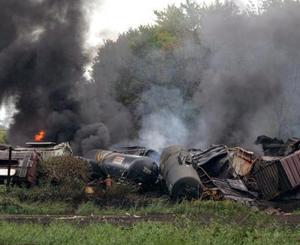HAZMATRailroads do not let HAZMAT teams know what is on train
Lethal chemicals roll through the backyards of cities and towns without the knowledge of these towns; residents; railroads do not share information about the schedule and contents of HAZMAT cargo with these towns’ emergency services, so the services cannot prepare for catastrophe; if chlorine or ammonia were to escape from a punctured tanker — in an accident or derailment — it would form a toxic cloud; a compromised 90-ton rail car of chlorine could create a plume fifteen miles long by five miles wide; the U.S. railroad industry transported some 75,000 tank cars of toxic inhalants nationwide in 2009

First responders need information about what is released // Source: cleveland.com
This is not a reassuring story. Trains carrying deadly chemicals rumble through the backyards of cities and towns every day, but railroad companies hauling them refuse to disclose exactly what those substances are, or how often they travel through the area.
Only the railroads are required to know what is in the cars they are shipping, said Federal Railroad Administration (FRA) spokesman Warren Flatau.
Local emergency workers, who would respond to a leak, spill, or fire, have no knowledge of what is being transported on those cars until an accident happens (see “Trains still carry lethal cargo through Dallas-Forth Worth, other American cities,” 4 May 2010 HSNW; .
What is the reason for this secrecy? Can local HAZMAT teams adequately prepare for emergencies if they are not sure which chemicals are being brought through and with how much frequency?
Binghampton Press-Connects’s Julia Hunter writes that railroad authorities say it is a matter of national security. Advocates for the public argue the rail cars are clearly marked, and if terrorists wanted to find a car full of hazardous material, they easily could. An Emergency Response Guidebook, used by first responders during derailments and other HAZMAT incidents, provides a list of codes and their corresponding chemicals. The information can also be found with a quick Internet search.
“They think that having the public know about the shipments of these cargoes is somehow a security
breach,” said Fred Millar, a Washington D.C.-based consultant on HAZMAT transportation issues and national security. “That is absolutely ridiculous. … These are gigantic tank cars with placards on the side going to and from the same places. The only people being kept in the dark are the American public.”
The FRA said while they do not disclose specifics, they make an effort to keep emergency workers informed. “Upon request, local officials will be provided … the top chemicals transported on an annual basis,” Flatua said. He noted they are not required to provide a list of every chemical transported, or the quantity — something Broome County, New York, emergency workers have been concerned about since a derailment of hazardous chemicals in June.
Hunter writes that two of three railroad companies that travel through Broome County, including the one that travels through Chemung and Steuben counties, refused to disclose a list of chemicals they transport when asked to do so by the Binghampton Press-Connects.
The smaller company — New York Susquehanna & Western Railway, which carries less
